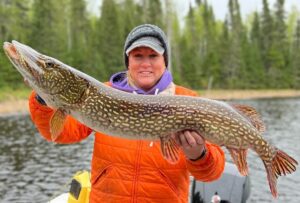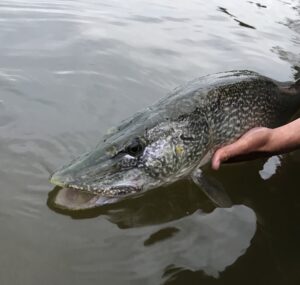NORTHERN PIKE (Esox lucius)
FOUND IN B.C.? Yes.
CURRENTLY KNOWN IN: Native to Northern BC, invasive in the Columbia River and Southern BC.
Identification
Northern Pike are the largest invasive freshwater fish in BC, and can grow to be up to 133 centimetres long. On average, these long, slender fish are 50-75 centimetres in length, have a pointed head, a large mouth filled with sharp teeth, and a long flattened snout that resembles a duck’s bill. Their dark green-brown back has many white spots, and their underside is a creamy white/silver colour. The sides of the Northern Pike are clearly marked with horizontal rows of yellow to white spots. The dorsal and anal fins of this fish are located near the tail and are usually green to yellow in colour, but can be orange or light red, and have irregular black markings. All of the fins of Northern pike are rounded.

Photo credit: Illinois Department of Natural Resources
Life Cycle
Typically, Northern Pike live for 8-10 years. They will spawn in the spring, following the ice melt. Northern Pike will randomly scatter their eggs in vegetated shallow water. The eggs then attach onto the vegetation. These fish breed in areas that may be dry the rest of the year but are flooded in the springtime.
Ecology
Northern Pike prefers habitats with cool, slow water and large amounts of vegetation. These fish are aggressive predators that are solitary and territorial. They lurk in the weeds and attack prey that dare to cross their path. Northern Pike are opportunistic feeders, and will consume whatever is available, including fish, frogs, mice, muskrats, crayfish, and young birds. They are capable of consuming up to one fifth of their body weight every day.

Photo credit: National Park Service
Introduction and Spread
Northern Pike are native to North America and Europe, and are widely distributed throughout the Northern hemisphere. Although they are native to the northern drainages of BC, they are invasive in southern BC. They are also common throughout Quebec, Ontario, and the Prairies. This fish has been intentionally introduced outside of its native range for recreational angling and commercial purposes.

Trophy Northern Pike caught in Ontario. Photo credit: Anderson’s Lodge
Impacts
Due to their aggressive predation on smaller fish, Northern Pike can rapidly consume large numbers of other game fish such as salmon, trout, bass, and perch. This has an impact on recreational fishing and the ecosystem health of the area that is invaded by this fish. Northern Pike introduce disease and outcompete native fish, and deplete freshwater systems of smaller prey species, pushing out the larger native fish and disrupting the natural food webs.

Northern Pike. Photo credit: Sub Artic Angling
What Can We Do?
To help prevent the spread of this invasive species, do not transport Northern Pike from one water body to another. Make sure to always Clean, Drain, and Dry all watercraft before and after use to avoid bringing aquatic invasive species to a new environment.
REPORT: Report all sightings of invasive species to CSISS on our website, to the Province with their online form or on the Report Invasive mobile app.

Literature and Resources:
- https://bcinvasives.ca/invasives/northern-pike/#:~:text=Northern%20pike%20is%20a%20predator,Provincial%20Priority%20Invasive%20Species%20List.
- https://www.dfo-mpo.gc.ca/species-especes/profiles-profils/northernpike-grandbrochet-eng.html
- https://www.oiso.ca/wp-content/uploads/Northern-Pike-Fact-Sheet-DOC.pdf
- https://dnr.illinois.gov/education/wildaboutpages/wildaboutfishes/wafpike/wafnorthernpike.html
- https://www.nps.gov/miss/learn/nature/northern-pike.htm